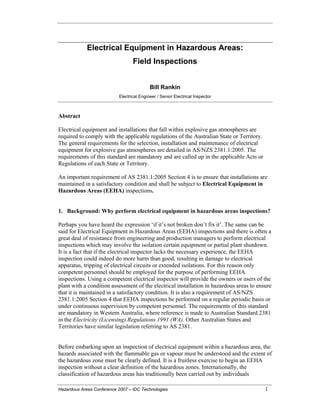How Roar Solutions can Save You Time, Stress, and Money.
Wiki Article
Roar Solutions for Beginners
Table of ContentsNot known Details About Roar Solutions How Roar Solutions can Save You Time, Stress, and Money.The Facts About Roar Solutions Uncovered
In order to shield installations from a possible surge a technique of analysing and categorizing a potentially dangerous area is called for. The function of this is to guarantee the correct choice and installation of tools to inevitably avoid an explosion and to make sure safety of life.
(https://www.video-bookmark.com/bookmark/6634779/roar-solutions/)
No devices must be mounted where the surface area temperature level of the devices is greater than the ignition temperature of the given threat. Below are some typical dust dangerous and their minimum ignition temperature. Coal Dirt 380C 225C Polythene 420C (thaws) Methyl Cellulose 420C 320C Starch 460C 435C Flour 490C 340C Sugar 490C 460C Grain Dust 510C 300C Phenolic Material 530C > 450C Aluminium 590C > 450C PVC 700C > 450C Residue 810C 570C The possibility of the threat being present in a concentration high sufficient to cause an ignition will certainly differ from area to place.
In order to identify this danger an installation is divided into locations of risk depending upon the quantity of time the unsafe is existing. These locations are described as Zones. For gases and vapours and dusts and fibers there are 3 zones. Area 0 Zone 20 A harmful environment is highly likely to be present and might exist for long periods of time (> 1000 hours per year) or also continuously Zone 1 Area 21 A hazardous atmosphere is feasible however unlikely to be existing for lengthy periods of time (> 10 450 C [842 F] A classification of T6 means the minimal ignition temperature is > 85 C [185 F] Hazardous location electrical equipment maybe made for use in greater ambient temperature levels. This would certainly indicated on the ranking plate e.g. EExe II C T3 Ta + 60C( This suggests at 60C ambient T3 will not be exceeded) T1 T1, T2, T3, T4, T5, T6 T2 T2, T3, T4, T5, T6 T3 T3, T4, T5, T6 T4 T4, T5, T6 T5 T5, T6 T6 T6 A T Course ranking of T1 implies the maximum surface temperature level produced by the instrument at 40 C is 450 C. Thinking the associated T Course and Temperature ranking for the devices are proper for the area, you can constantly make use of a tool with a more rigid Division ranking than required for the location. There isn't a clear answer to this question. It actually does depend on the sort of tools and what repair services require to be brought out. Tools with particular examination procedures that can't be executed in the field in order to achieve/maintain third party ranking. Must return to the manufacturing facility if it is before the equipment's solution. Field Fixing By Authorised Worker: Complicated testing might not be needed nevertheless particular treatments may need to be complied with in order for the tools to preserve its 3rd party rating. Authorised employees must be employed to do the job appropriately Repair should be a like for like substitute. New element must be considered as a direct replacement calling for no unique testing of the tools after the repair work is total. Each item of devices with an unsafe ranking should be reviewed independently. These are outlined at a high level below, however, for more comprehensive information, please refer directly to the guidelines.
Little Known Questions About Roar Solutions.
The devices register is an extensive data source of devices records that consists of a minimum set of fields to identify each product's location, technological criteria, Ex classification, age, and ecological data. This information is vital for tracking and taking care of the equipment efficiently within hazardous areas. In comparison, for routine or RBI sampling examinations, the grade will be a mix of Comprehensive and Close examinations. The ratio of Thorough to Close evaluations will be established by the Equipment Danger, which is assessed based on ignition danger (the probability of a source of ignition versus the likelihood of a flammable environment )and the dangerous location classification( Zone 0, 1, or 2). This variant will certainly also affect the resourcing needs for work preparation. When Lots are defined, you can establish tasting plans based on the sample size of each Great deal, which describes the variety of random tools items to be examined. To establish the required sample size, two elements require to be reviewed: the dimension of the Lot and the category of assessment, which shows the degree of initiative that need to be used( decreased, typical, or enhanced )to the evaluation of the Great deal. By integrating the classification of inspection with the Lot size, you can after that develop the ideal denial standards for an example, suggesting the allowed variety of defective items located within that sample. For more information on this procedure, please describe the Energy Institute Standards. The IEC 60079 typical recommends that the maximum interval between inspections ought to not exceed 3 years. EEHA inspections will likewise be carried out outside of RBI projects as component of arranged maintenance and devices overhauls or repair work. These evaluations can be attributed towards the RBI example sizes within the influenced Whole lots. EEHA inspections are performed to recognize mistakes in electric devices. A weighted scoring system is essential, as a single item of devices may have several mistakes, each with varying degrees of ignition threat. If the mixed score of both evaluations is much less than two times the fault rating, the Great deal is deemed appropriate. If the Lot is still taken into consideration inappropriate, it must go through a complete assessment or justification, which may set off more stringent assessment protocols. Accepted Great deal: The causes of any mistakes are identified. If a typical failing mode is discovered, additional tools may call for evaluation and repair work. Mistakes are classified by intensity( Security, Honesty, House cleaning ), making certain that urgent concerns are assessed and attended to immediately to mitigate any type of effect on security or operations. The EEHA database ought to track and click here to find out more record the lifecycle of mistakes in addition to the corrective actions taken. Executing a robust Risk-Based Examination( RBI )technique is critical for guaranteeing conformity and safety in handling Electrical Equipment in Hazardous Areas( EEHA) (eeha certificate). Automated Mistake Rating and Lifecycle Administration: Effortlessly handle faults and track their lifecycle to improve inspection accuracy. The introduction of this support for risk-based assessment further strengthens Inspectivity's position as a best-in-class service for regulative compliance, in addition to for any kind of asset-centric inspection usage instance. If you want discovering more, we invite you to request a demonstration and discover how our service can transform your EEHA management procedures.
Facts About Roar Solutions Revealed

In regards to eruptive risk, a hazardous area is a setting in which an explosive atmosphere exists (or might be expected to be existing) in quantities that require unique precautions for the construction, installation and use tools. high voltage courses. In this short article we explore the challenges encountered in the work environment, the risk control measures, and the needed competencies to function securely
These substances can, in particular conditions, create explosive ambiences and these can have significant and awful repercussions. Many of us are familiar with the fire triangle eliminate any kind of one of the 3 elements and the fire can not occur, however what does this mean in the context of unsafe locations?
In most instances, we can do little concerning the degrees of oxygen airborne, yet we can have significant influence on sources of ignition, for example electrical equipment. Dangerous areas are recorded on the hazardous area classification drawing and are recognized on-site by the triangular "EX LOVER" indicator. Below, among various other essential info, zones are split right into three kinds relying on the danger, the chance and period that an explosive atmosphere will exist; Area 0 or 20 is regarded the most hazardous and Area 2 or 22 is regarded the least.
Report this wiki page